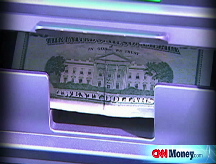Treasurys edge higher as December winds down
Investors continue to seek the safety of government-backed bonds as bank-to-bank lending rates continued to ease, though at a slower pace than just a month ago.
NEW YORK (CNNMoney.com) -- Treasurys rose Monday as investors continued to seek out the safety of government-backed bonds in the last few trading days of the year.
Meanwhile, bank-to-bank lending rates continued to ease though at a slower pace than just a month ago, signaling some equilibrium may be near.
The price on the benchmark 10-year note rose 5/32 to 114-15/32 and its yield dipped to 2.10% from 2.13% Friday.
Bond prices and yields move in opposite directions.
The 30-year long bond fell 1-1/32 to 137-22/32 and its yield edged up to 2.64% from 2.61%.
The 5-year note rose 9/32 to 100-7/32 and its yield slipped to 146% from 1.51%.
The 2-year bond increased 8/32 to 100-6/32 and its yield dipped to 0.79% from 0.88%.
Meanwhile, the 3-month yield - widely considered a gauge of investor confidence - edged up to 0.02% from 0.015%. Yields hovering around the 0% level suggest investors are highly risk averse.
The government has been auctioning off debt to pay for bailout programs. On Monday, Treasury auctioned off $26 billion of 90-day bills and a $27 billion of 181-day bills.
However, as jittery investors continue to be battered by volatile equity markets, Treasurys may be forming their own bubble.
"Treasurys are acting a lot more like tech stocks: almost no sense of logic whatsoever," said Joe Clark, managing partner at Financial Enhancement Group.
Credit ease. The 3-month Libor was little changed at 1.46%. Rates were not tallied Thursday (Christmas) or Friday (U.K. bank holiday.
Libor - the London Interbank Offered Rate - is a daily average of rates 16 different banks charge each other to lend money in London, and it is used to calculate adjustable-rate mortgages. More than $350 million in assets is tied to Libor.
Libor rates have come down after a huge spike in October during the height of the credit crisis, as central banks worldwide have worked to inject liquidity into the global economy.
In fact, the 3-month Libor was at 2.22% just a month ago. And on Oct. 14, the measure reached 4.82%, the highest since mid-December 2007.
"Confidence is beginning to reemerge," said Clark. "Banks were skeptical of other banks, and that has dissipated a bit. They're giving credit to those who deserve it."
Market gauges. Two market gauges painted a mixed picture of confidence.
The "TED spread," a measure of banks' willingness to lend, slipped to 1.4 percentage points - very near the rate before the September collapse of Lehman Brothers.
The higher the spread, the more unwilling investors are to take risks. The rate has skyrocketed as the credit crunch exploded into a crisis, but it has fallen since the government put trillions of dollars into credit-easing programs in recent months.
Another indicator, the Libor-OIS spread, rose to 1.27 percentage points from last Wednesday's rate of 1.24 percentage points. The Libor-OIS spread measures how much cash is available for lending between banks, and is used for determining lending rates. The bigger the spread, the less cash is available for lending.
The Libor rates stand well above their central bank benchmarks, however, in a sign that financial system is still under stress. The Federal Reserve, the Bank of England and the European Central Bank have all slashed interest rates and made additional credit available to banks in hopes it will spark lending.
"When you cut interest rates when they're already this low, it's almost more widow dressing than it is reality," Clark said. "When everything is said and done, 2008 will be remembered more for what happened to the credit markets, not the stock markets." ![]()



